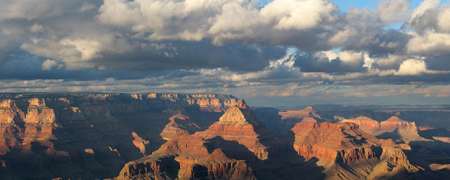Grand Canyon Geology and Age
Grand Canyon Geology
At 250 million years old the Kaibab limestone is the youngest geologic layer found in the Grand Canyon. Although it is now 7,000 feet above sea level this layer was formed due to deposition from an ocean full of fish, brachiopods, and other marine life. It was the geologic uplift of the Colorado Plateau that moved this layer to its current elevation. The oldest geologic layer in the Grand Canyon is the Vishnu Complex, comprised primarily of Vishnu Schist, ancient formations metamorphosed into the black schist we see today, which is some of the oldest exposed rocks on earth.
Geologic Layers of the Grand Canyon
Except for the Vishnu complex, the Grand Canyon is made of metamorphic rock. The major layers of the Grand Canyon from the Rim of the Grand Canyon to the Colorado River are:
- Kaibab Limestone
- Toroweap Formation
- Coconino Sandstone
- Hermit Shale
- Supai Group
- Redwall Limestone
- Temple Butte Limestone
- Muav Limestone
- Bright Angel Shale
- Tapeats Sandstone
- The Super Group
- The Vishnu Complex.
How old is the Grand Canyon?
The age of the Grand Canyon is a much-debated topic. Up until recently most geologist agreed it formed 6-10 million years ago, but new evidence has been brought to the table that the parts of the canyon started forming nearly 70 million years ago. Many geologists now believe that the Grand Canyon as we know it today is only 6 million years old, but separate canyon systems that were much older were linked together by an ancient river that flowed across the Colorado Plateau. This is just a basic summary of Grand Canyon Geology as people can and do spend their whole life studying it. For more information check Grand Canyon National Parks page on Grand Canyon Geology and the formation of the Grand Canyon.





